The automobile featured in this article is a 1953 Kaiser Manhattan. The Kaiser Manhattan was produced for the 1952 and 1953 model years. Another supercharged Manhattan model came out in 1954/55 but is separate from the 1952/53 series. Only a total of about 4,000 supercharged Manhattans were built in 54/55.
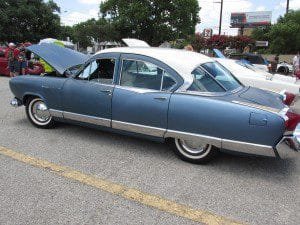
The Manhattan was advertised by Kaiser as being the safest car on the road. This basic design, as mentioned above, continued in the Kaiser line until the company discontinued building U.S. passenger cars in 1955.
The Automakers Post War
After the end of World War Two, the independent automakers had to spend a lot of money to keep up with the Big Three. The Kaiser Motor Corporation, formerly the Kaiser -Frazer Corporation, was one of several independent auto makers who fell victim to the Big Three when the post World War Two car demand began to wane.There was such a pent up demand for automobiles when the war ended that essentially everyone was selling cars. When that demand began to wane, the smaller independents started having problems. In 1951 Kaiser-Frazer came out with the low priced economy “Kaiser J” model to try to help the sagging sales numbers. The Kaiser J gave the buyer a choice of a four or six cylinder engine.
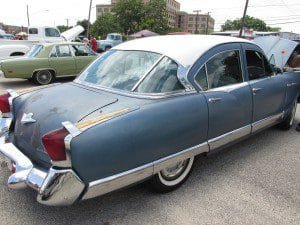
The biggest challenge for the non-three major auto makers, Ford GM and Chrysler, was having the financial resources necessary to tool up for new designs. As an good example, a Kaiser-Frazer press release stated that $10 million was spent to make the 1949 models more sleek and modern looking. After the first post war designs hit the showrooms changes were made more rapidly especially during the 1950’s. The Big Three were taking the lions share of business during the 1950’s and the independents that were still around were fighting over the table scraps.
Kaiser-Frazer Willow Run Factory
Kaiser-Frazer automobiles were built at their Willow Run facility just about 25 miles west of Detroit. Ford Motor Company had used the facility to build bombers during the war and the plant was massive. Ford gave up the factory after the war and the government leased it to Kaiser-Frazer.
The Kaiser Manhattan
The Kaiser Manhattan was the vehicle that kept Kaiser-Frazer going during the early 1950’s. The Manhattan model actually hit the showrooms in 1950 as a Frazer Manhattan. The model was transferred to the Kaiser nameplate in 1952. In 1953 the Kaiser Manhattan could be ordered as a two-door club sedan, a four-door sedan, and a Traveler sedan.
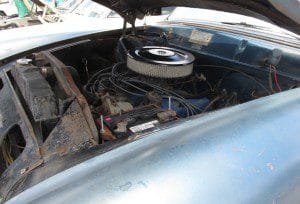
The Manhattan, representing the top trim level for 1952 and for 1953 the mid-level version below the luxurious Dragon model. As far as changes with the Kaiser Manhattan from 1952 to 1953, the latter models had widened chrome headlamp rings, counterbalanced trunklid hinges, redesigned white-on-black instrumentation, a new hood ornament and a lowered rear seat cushion for better headroom.
The lower bodies of the 1953 models had a wide chrome band, there were small chrome tail fins that sat atop the rear fenders, and the car’s front fenders were decorated with script nameplates.
1953 Kaiser Manhattan Specifications
Both the 1952 and 1953 Kaiser Manhattans were outfitted with the “Supersonic Six,” the long-running 226 cubic inch L-head straight-six cylinder engine. The engine was engineered and designed by Continental. Horsepower was rated at 118. Regarding the name of the engine. the “Supersonic Six”, the American automotive industry pretty much wrapped itself around all things aerospace. The Oldsmobile Rocket 88 is a good example.
The standard transmission on the Kaiser Manhattans was a column shifted three speed manual Borg Warner unit. Available as an option was a four speed Hydra-Matic automatic from GM.
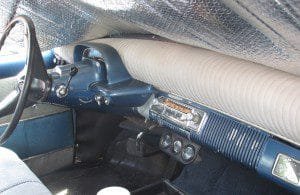
Brakes on the Kaiser Manhattan were four wheel Bendix drums.
Front suspension were independent coil springs and tubular hydraulic shocks in along with a linkless anti-roll bar. Rear suspension was a solid axle suspended by semi-elliptic longitudinal leaf springs and canted tubular hydraulic shocks.
Kaiser offered a wide selection of colors and upholstery choices. As a result the buyer could make his or her interior very personalized.
The Kaiser Manhattan had a wheelbase of 118.5 inches. The overall length was 211.1 inches ( compared to the 208.5 inches in 1952) and the width was 74.875 inches. The curb weight varied and averaged about 3,400 lbs.
The Kaiser Manhattan new car price averaged about $2,600.
You may also be interested in the AutoMuseumOnline articles on the links below…
A Restored 1953 Studebaker Champion
Locations of VIN Plates and Stamps on Vintage Vehicles
1964 Rambler Ambassador Cross Country Wagon
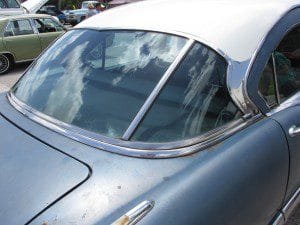
The Kaiser Manhattan Collector Car
The Kaiser Manhattan’s are popular collector cars and they are rare. Produced only during the 1952 and 1953 model years there was only a total of 37,000 vehicles built which included all Manhattan models.
You should be able to find Kaiser Manhattans for sale in a wide range of conditions. Finding one in top condition might not be as easy. AS of this writing, asking prices for the 1952/53 models may range from $2,500 to $40,000. This range covers non restored vehicles needing an engine rebuild to museum quality vehicles.
As of this date, a drivable 54 model in need of repair and restoration is being offered for about $8,000. A couple of other 54 models with rebuilt engines are in the range of $15,000 to $25,000. Also, a 1953 model in very good condition has an asking price of $15,000. A 1952 Manhattan is priced at $9,000. As you can see from the above, prices are in a wide range depending on both mechanical and cosmetic condition.
(Article and photos copyright 2014 AutoMuseumOnline)